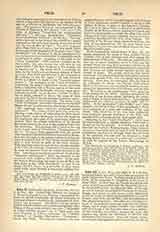

Felix III, Saint, POPE (483-492), b. of a Roman senatorial family and said to have been an ancestor of Saint Gregory the Great. Nothing certain is known of Felix, till he succeeded St. Simplicius in the Chair of Peter (483). At that time the Church was still in the midst of her long conflict with the Eutychian heresy. In the preceding year, the Emperor Zeno, at the suggestion of Acacius, the perfidious Patriarch of Constantinople, had issued an edict known as the Henoticon or Act of Union, in which he declared that no symbol of faith, other than that of Nice, with the additions of 381, should be received. The edict was intended as a bond of reconciliation between Catholics and Eutychians, but it caused greater conflicts than ever and split the Church of the East into three or four parties. As the Catholics everywhere spurned the edict, the emperor had driven the Patriarchs of Antioch and Alexandria from their sees. Peter the Tanner, a notorious heretic, had again intruded himself into the See of Antioch, and Peter Mongus, who was to be the real source of trouble during the pontificate of Felix, had seized that of Alexandria. In his first synod Felix excommunicated Peter the Tanner, who was likewise condemned by Acacius in a synod at Constantinople. In 484, Felix also excommunicated Peter Mongus—an act, which brought about a schism between East and West, that was not healed for thirty-five years. This Peter, being a time-server and of a crafty disposition, ingratiated himself with the emperor and Acacius by subscribing to the Henoticon, and was thereupon, to the displeasure of many of the bishops, admitted to communion by Acacius.
Felix, having convened a synod, sent legates to the emperor and Acacius, with the request that they should expel Peter Mongus from Alexandria and that Acacius himself should come to Rome to explain his conduct. The legates were detained and imprisoned; then, urged by threats and promises, they held communion with the heretics by distinctly uttering the name of Peter in the reading of the sacred diptychs. When their treason was made known at Rome by Simeon, one of the “Accemeti” monks, Felix convened a synod of seventy-seven bishops in the Lateran Basilica, in which Acacius as well as the papal legates were excommunicated. Supported by the emperor, Acacius disregarded the excommunication, removed the pope’s name from the sacred diptychs, and remained in the see till his death, which took place one or two years later. His successor Phravitas, sent messengers to Felix, assuring him that he would not hold communication with Peter, but, the pope learning that this was a deception, the schism continued. Peter having died in the meantime, Euthymius, who succeeded Phravitas, also sought communion with Rome, but the pope refused, as Euthymius would not remove the names of his two predecessors from the sacred diptychs. The schism, known as the Acacian Schism, was not finally healed till 518 in the reign of Justinian. In Africa, the Arian Vandals, Genseric and his son Huneric, had been persecuting the Church for more than 50 years and had driven many Catholics into exile. When peace was restored, numbers of those who through fear had fallen into heresy and had been rebaptized by the Arians desired to return to the Church. On being repulsed by those who had remained firm, they appealed to Felix, who convened a synod in 487, and sent a letter to the bishops of Africa, expounding the conditions under which they were to be received back. Felix died in 492, having reigned eight years, eleven months and twenty-three days.
AMBROSE COLEMAN


